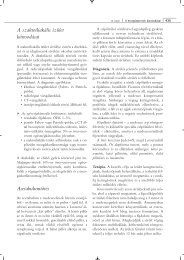FALL Protection 2007
FALL Protection 2007
FALL Protection 2007
- No tags were found...
Create successful ePaper yourself
Turn your PDF publications into a flip-book with our unique Google optimized e-Paper software.
Systems for Ascent and DescentAscent using theFOOT-LOCK techniqueManual ascenders and specific knots allow the climber toaccess and position himself in a hands-free position at anypoint along the climbing line.The ascender device is fixed to either side of the climbingline and attached to the climber’s belt, the climber then usesthe Foot-Lock technique to ascend the rope. Standing up inthe foot stirrups, the climber pushes the ascending deviceup along the climbing line. While hanging from the knots orascender, he then slides up the foot stirrups and thenrepeats the movement to thus move up the line.Ascent, Descent andWork Positioning withAuto-blocking knotsThe most efficient method for ascent, descentand work positioning in tree-pruning.These knots run smoothly along the climbingline.Connected to the climbing belt by means of akarabiner, the climber’sbodyweight blocks the knot onto the rope.Easy to tie and use, these knots can beadapted to all types of climbing lines.Double JumarManual AscenderThese metal handles attach to either side of theclimbing line and are used in conjunction with the“Foot-Lock” technique.Only suitable for ascent; the climber uses analternative device for the descent.- Anodised light alloyedaluminium- Net weight: 0.4kgRef.: 10 030 45ArboricultureSplit TailsRef.: 10 034 29- Suitable for the following knots: Prussik,Swabish, and Valdotain- Ø 10mm polyester rope with two stitchedsplices.- Length: 1m- Weight: 0.115kg- Conforms to EN1891Ref.: 10 034 28- Suitable for the following knots: Prussik,Swabish and Blake- Ø 12mm polyester rope with two stitchedsplices- Length: 1.1m- Weight: 0.155kg- Conforms to EN1891A. The Prussik KnotThe basic tree-climbing knot, the Prussik can be used forboth ascent and descent.In humid conditions or after a prolonged use, this knot mayjam on the line and can prove difficult to release. The splittail should have a smaller diameter (10 and 12mm) than theclimbing line (13mm or 12mm).B. The Blake KnotSlides smoothly along the climbing line and will grip firmlywithout jamming.For this knot the Split Tail and Climbing Line should ideallybe the same diameter. This knot blocks onto the rope in onedirection only.C. The Prussik Swabish KnotThis progressive friction knot offers a smooth performancealong the line without jamming. This knot will block onto therope in one direction only. The split tail should have a loop orknot on the ends. Depending on the conditions, further turnsor braids can be added to this knot.D. The Valdotain KnotA complicated knot which offers a very fluid and responsiveperformance.Primarily used for descent, when released the knot willblock immediately on the rope. Care must be taken as theknot allows a rapid descent with little effort. By addingfurther braids or turns, the climber can adapt this knot tothe type of climbing line used or to a more humid workingenvironment.ACBD59












